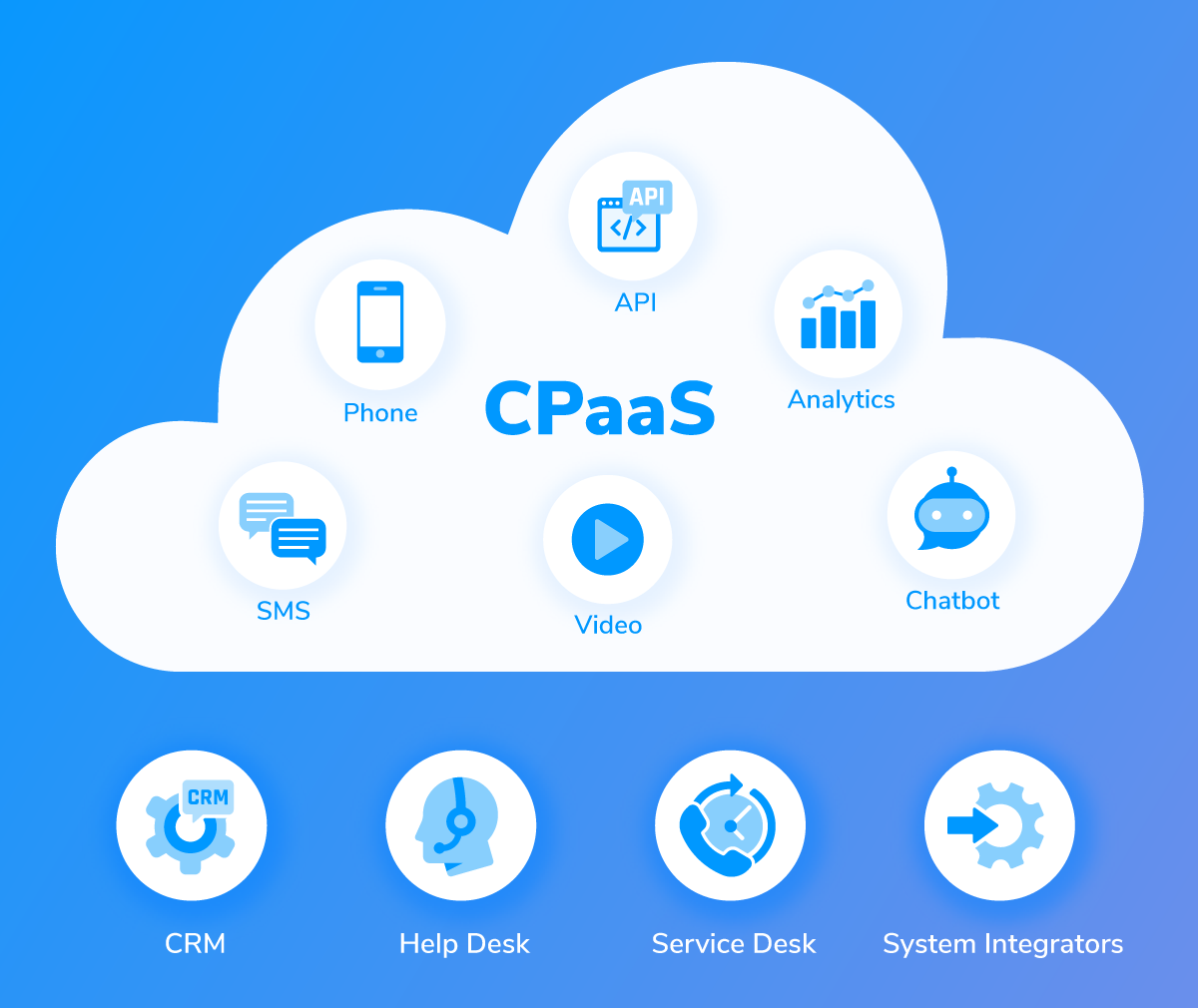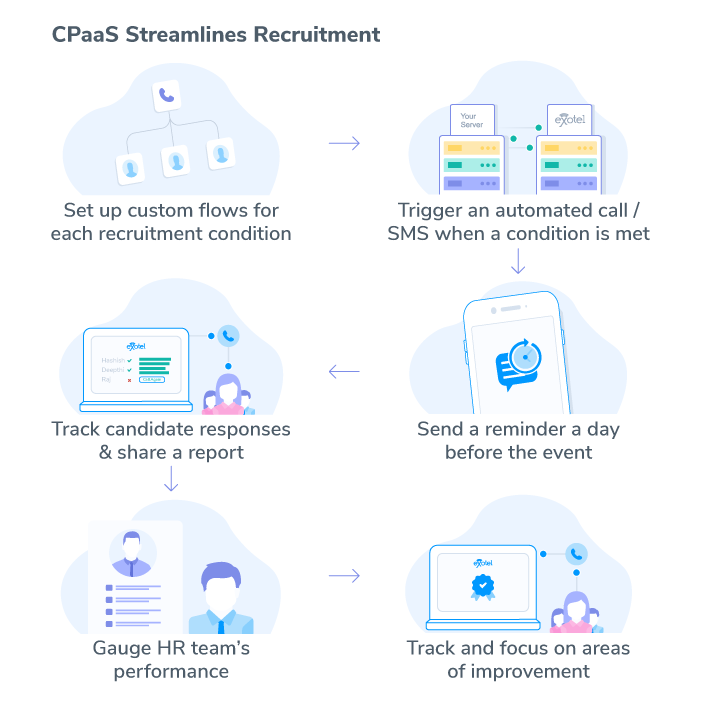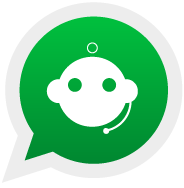 May 5, 2021
May 5, 2021 7 mins read
7 mins readBusiness communication is evolving. Customers have a range of preferences, and businesses are listening. They are supplementing existing channels like email with automated, new-age channels like chatbots. To offer better personalisation even if customers shifted across channels, businesses need an integrated communication stack.
However, setting up the communication logic behind the scenes is no easy task. Typically, you need to build and deploy each channel from the ground up and integrate it.
Thankfully, there is a simpler path. Here’s where CPaaS comes into play. Feel free to jump straight ahead to any of the following sections:
CPaaS or Communication Platform as a Service offers a ready-to-deploy framework in the cloud for your business. With it, you can easily add real-time capabilities like voice, messaging and video to your website or any other customer-facing offering like an app. This is made possible through CPaaS offering APIs (Application Programming Interfaces) to connect both the endpoints.

As visualised, the platform can, for instance, offer a messaging API for a chatbot to function on the website. That way, it can interact with the customer and work in tandem with internal business systems to deliver appropriate responses. Channels are hosted on a single framework, and data can be centralised and used to deliver 360-degree customer context for better customer experiences.
We also hinted at CPaaS allowing you to customise the set of channels or tools needed for a target front-facing offering. You get to manage just the host of tools needed at this point in time. That allows you to cut unnecessary spending on tools that would come with any other platform offering pre-installed apps with no room for customisation.
With a CPaaS platform, you get access to APIs that can be set up to support communication triggers for simple or complex use cases. This could include an e-commerce order triggering a series of events. At different stages of the order journey, you can set up automated status alerts to both the customer and the supplier (or the warehouse) using these APIs. This improves the customer experience and allows for transparency in tracking the order. It also helps keep things going smoothly. There are numerous other real-life applications that can be supported using CPaaS, and we talk about it further ahead in this piece.
Leveraging a Communication Platform as a Service (CPaaS) provider to meet your customer communication requirements isn’t complicated. For any business owner or head of the customer support division, having a developer or basic know-how might just be enough. However, a CPaaS solution provider must be able to offer added assistance in the form of:
UCaaS, or Unified Communications as a Service is a ready-to-use cloud communication platform that comes pre-built with call conferencing, VoIP calls, or business messaging capabilities. Also, UCaaS is managed by a platform provider and can be deployed from the day of purchase without worrying about maintenance. However, the biggest drawback of UCaaS is the inability to customise it according to your requirements given the provider controls how the platform runs.
On the other hand, CPaaS offers a similar framework in the cloud to connect voice and messaging to your enterprise tech stack with the help of APIs. However, unlike UCaaS, it doesn’t lock you into a pre-configured bundle of communication as a service apps from any particular vendor.
Think of UPaaS and CPaaS in the context of buying a stock or a customised car. A stock car is pre-configured with no scope of modifications. That’s UCaaS. Nowadays, however, there is a growing trend of “building your own car” in terms of choosing and omitting specific features or add-ons. That’s CPaaS, allowing you to modify communication tools with APIs.
Depending on your business requirement, you can opt for one of the models. Usually, a Communication Platform as a Service is chosen to allow for changes to be made as the nature of your business communication evolves.
While you have a fair idea of the way CPaaS works, let’s look at all the primary advantages it can bring to your business:
1. Scale at will: CPaaS allows businesses to scale up quickly, easily and reliably. This is especially true for businesses with a growing customer base or those experiencing seasonal surges in calls or SMS. The APIs make it easy to accommodate high volumes whenever required given the nature of a cloud solution allowing unlimited capacity when required.
2. Fully customisable: With a CPaaS platform, you can tailor-make a communications workflow to meet your customers’ preferences. And you get to keep data within the four walls of your business to respect the promise of data security made to customers.
3. Affordable: The cloud communication platform adapts to your communication needs. Subsequently, whenever there are non-critical channels that can be discontinued from use, CPaaS allows you to make necessary changes easily. In addition, you can avoid the hassle of purchasing and maintaining backend hardware or network infrastructure that comes with an on-premise versus a cloud solution.
4. Contextual, omnichannel Communication: With CPaaS, you have APIs that allow you to integrate messaging or calling with your CRM or helpdesk software. This gives you complete control over how these channels can be used to fit your customer’s preferences well.
And the communication platform gives you access to voice, video, and SMS APIs to design an omnichannel experience for communication on the channel of your customer’s choice. Through data collected from the different APIs, agents can have contextual conversations even when customers switch channels during an ongoing support ticket or sales conversation.
5. Quick resolution: Poor support and sales turnaround times continue to drop customer satisfaction levels. CPaaS allow tools to work together with customer-facing functional software like a CRM or helpdesk app and set up workflows when any action is met.
For instance, after a salesperson’s first call with a prospect, CPaaS can trigger the CRM app to record data tracked from a cloud telephony app and transfer it to the notes of a new deal created in the CRM. Such workflows reduce manual work to manage leads and allows reps to focus on complex sales scenarios.
6. Data-driven: Without feedback, you wouldn’t know what is working and what is not. The digital nature of the CPaaS platform tracks metrics around customer engagement which are captured through the APIs and can be analysed to make decisions.
After a fair understanding of Communication as a Service, here’s a look at the most commonly used business situations. The list isn’t exhaustive and can be adapted to suit specific business requirements of the below applications and far more too.
1. Emergency responses: CPaaS easily and reliably manages critical communication during a crisis, including responding to customer concerns, tracking employee safety, or even if your business finds an opportunity at scale to assist the government or communities.
At Exotel, we are helping multiple state governments help the general public during the pandemic. Case in point: We helped a few officials from the Karnataka government who teamed up voluntarily to answer enquiries related to COVID through a helpline number. They were able to quickly stand up a virtual call centre solution to route requests to their team members and resolve them systematically
2. End-to-End Order Shipping Information: The power of a Communication Platform as a Service (CPaaS) comes to the fore across an e-commerce journey. Be it setting up SMS updates at every stage of the shipping journey or scheduling a reverse pick-up in case of a return request by the customer, communication as a service manages communication between the front- and back-end of enterprise systems. It sends the right data through messaging or call APIs so a channel like email or SMS can share updates with the customer. Also, agent productivity can improve when CPaaS allows a smart IVR layer to auto-respond to routine queries.
Customer Instance: Urban Ladder uses Exotel to respond to all customer calls and boost CX
3. Reduce Delivery Reschedules & Track Agent Performance: As pioneers of being an enterprise-ready cloud communication platform in India, executives at large food delivery or ride-hailing apps like Zomato and Ola came to us with a common concern: reducing reschedules and no-shows by agents or drivers. To verify claims of agents unable to deliver at the first attempt to unresponsive customers, the firms needed proof through data.
With a virtual number that allows supervisors to monitor calls made, customer pick-up rates, or the number of call re-attempts, teams now have real insights to manage productivity and reduce second or third delivery attempts. With a communication platform, even data from a chat tool through firms like Zomato and Ola can be matched with data from the cloud telephony app and be evaluated for ways to improve CX.

Customer Instance: How Exotel helps Ekart connect their delivery agents and customers while maintaining privacy and offering superior communication
4. Streamline Recruitment: Recruitment is another key field where CPaaS can play a big role in improving and automating processes. To inform candidates and interviewers of upcoming interviews or send reminders for documents to be uploaded, a messaging API can be set up to schedule an SMS campaign that delivers text messages on time and to the right profiles.
Here’s another instance. Based on predefined triggers like the interviewer sharing consent to push the candidate to the next stage, CPaaS can trigger a call from the cloud telephony app to inform the latter to proceed.

Customer Instance: Learn how Exotel empowers jobseekers to find jobs via Babajob
5. Transfer Of Secure Information: For businesses in the financial, healthcare or even transportation or last-mile delivery space, communication becomes critical given it involves their customer’s personal data and recent transaction information. The communication platform manages two-factor authentication capabilities through SMS or voice which adds a critical security layer to passwords. In addition, it allows for anonymising personal information like a customer’s number so that personally identifiable information like a phone number or email cannot be visible to a delivery agent.
Our work with DocEngage, a healthcare CRM (HCRM) brings out the power of a Communication Platform as a Service (CPaaS) provider. A few years ago, their team was looking for ways to both improve the productivity of their customer’s (hospital) sales reps and tailor conversations they were having with customers. Back in the day, they integrated Exotel’s CPaaS into their HCRM with the power of our Call and Bulk SMS APIs. Today, we know that productivity in this sector is critical.
Exotel manages their incoming or outgoing calls and sends appointment reminders via SMS. It allows sales and support employees to retrieve a patient’s medical history before picking up an incoming patient call. This is possible with Exotel displaying a pop-up on the CRM for the rep’s convenience.
This is just a simple example of what is possible through CPaaS.
If you are looking for a CPaaS platform to add voice and messaging to your app (or website), contact us and one of our advisors will connect to understand how we can help.
